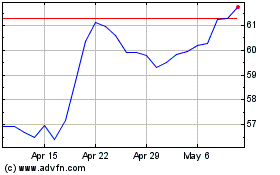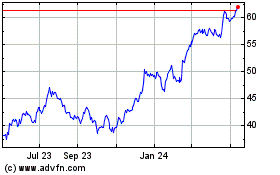Forever 21 Rethinks Its Love of Giant Stores--update
August 31 2015 - 9:31PM
Dow Jones News
By Matt Jarzemsky, Dana Mattioli and Suzanne Kapner
Fast-growing teen retailer Forever 21 Inc. is sounding out
landlords about downsizing some of its biggest stores, according to
people familiar with the matter.
The company is also in talks with Wells Fargo & Co. and TPG
to obtain a $150 million loan to bolster its balance sheet, some of
these people said. The financing is a rare instance of the closely
held company turning to outside investors, the people
continued.
Forever 21, which discloses little about its finances, has
predicted that sales would rise 10% this year to $4.7 billion. But
people familiar with the company say its sales and profit have
tapered off after years of strong growth. The company has stumbled
by expanding into cavernous stores that it had trouble filling
productively, they said.
Brian Tunick, an analyst with RBC Capital Markets, estimates
that excluding newly opened or closed stores Forever 21's sales
have been running negative for the past 12 months.
"After several years of fantastic results," Mr. Tunick said,
"they are facing some of the same struggles that other teen
retailers are facing."
Those challenges include pricing pressures as frugal shoppers
seek out ever-better deals and the changing tastes of fickle teens,
who increasingly prefer to create individual looks rather than
buying from big chains. Abercrombie & Fitch Co., American Eagle
Outfitters Inc. and Aeropostale Inc. have reported slumping sales,
while other chains, including Wet Seal Inc. and Delia's Inc., have
filed for bankruptcy protection.
Forever 21's low priced fashions, including $8 tops and $10
sweaters, ushered in a deflationary cycle that has left apparel
retailers reeling. Prices for women's clothes have fallen 13% since
2000, according to figures that Mr. Tunick compiled from
Euromonitor and RBC. In women's tops, where Forever 21 is
strongest, prices have declined 23% over that period.
Those pricing pressures are unlikely to let up. Forever 21 has
begun a new chain called 21Red that appeals to a wider swath of
customers and offers prices below the flagship brand.
Forever 21 has expanded into new categories, including plus
sizes, accessories and intimate apparel, and it is making a push to
appeal to older shoppers. But it has had trouble getting the sales
it needs to make its large stores productive. The company has
opened stores in recent years--including a 90,000-square-foot store
in New York's Times Square, a 94,000-square-foot store in San
Bernardino, Calif., and a 127,000-square-foot store in Las
Vegas--that are double and triple the size of previous
locations.
The retailer is in talks with landlords about downsizing some of
its bigger spaces. The company is in discussions with Simon
Property Group about reducing the 100,000-square-foot space it
occupies in the Tacoma Mall in Tacoma, Wash., that it took over
from Nordstrom in 2010, according to people familiar with the
situation. These people said that Forever 21 will continue to have
a presence at the mall, but a smaller one.
"Forever 21 was less disciplined than some of their competitors
in terms of the size of the box they occupied," said Gary Lewis, a
real-estate consultant. "Now they are approaching landlords about
taking some of that space back."
The retailer, which has 720 stores and plans to open 100 more
this year, has also struggled with large stores in Europe. The new
loan is expected to help fund expansion in South America, according
to people familiar with the situation, but could also be used to
buyout leases at struggling European stores.
Up until now, the company has taken on hardly any debt to fund
its expansion, using cash flow from operations and a credit line
from Wells Fargo, the people said.
Forever 21 traces its roots to a 900-square-foot store on
Figueroa Street in Los Angeles, opened in 1984 by Korean immigrant
Don Chang and his wife, Jin Sook. Mr. Chang and his wife keep a
tight control on the company, which is why they arranged the loan
quietly, rather than engaging in a broad marketing process that
would have involved disclosing financial information to a wide
range of hedge funds and private equity firms. Mr. Chang said in
July that business continues to be strong.
Mr. Tunick, the RBC analyst, estimates that Forever 21 commands
a 10% share of the U.S. apparel market, up from 3% in 2003. By his
assessment, Forever 21 has grown its U.S. market share faster over
that period than any other retailer, including Hennes &
Mauritz's H&M chain.
Write to Suzanne Kapner at Suzanne.Kapner@wsj.com, Matt
Jarzemsky at matthew.jarzemsky@wsj.com and Dana Mattioli at
dana.mattioli@wsj.com
Subscribe to WSJ: http://online.wsj.com?mod=djnwires
(END) Dow Jones Newswires
August 31, 2015 21:16 ET (01:16 GMT)
Copyright (c) 2015 Dow Jones & Company, Inc.
Wells Fargo (NYSE:WFC)
Historical Stock Chart
From Mar 2024 to Apr 2024

Wells Fargo (NYSE:WFC)
Historical Stock Chart
From Apr 2023 to Apr 2024
